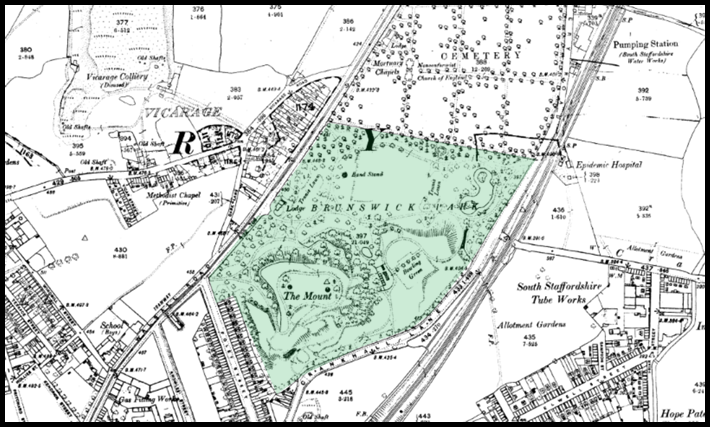|
|
Brunswick Park, Wednesbury |
|
|
On 25th August 1885 a meeting of the 'Local Board of Health' put forward the idea for a public park in Wednesbury. The 'Midland Advertiser' reported that 'Nothing in Wednesbury is more needed or desired to benefit the working classes'. In 1866 the newly elected Borough Council for Wenesbury made the provision of a public pleasure park their first goal, anticipating completion of the project in time for the Golden Jubilee celebrations of Queen Victoria, due the following year.
A site of twenty four acres was chosen lying between Walsall Street (now called Wood Green Road) and Cranehall Lane (later renamed Brunswick Park Road). It was made up of former coal workings and a vast pit mound and was purchased from the Patent Shaft and Axletree Company for £3,000, making it possibly the country's very first derelict land reclamation scheme The site neighboured the twelve and a half acre cemetery, which was consecrated in 1868, itself reclaimed industrial land. Giving the area an open aspect and plenty of 'fresh air'.
His plan at Wednesbury was to retain the pit mound (later called 'The Mount') which, when ascended by its network of terraced paths - lined with foundry slag - gave breathtaking views over the park's lawns, flower beds and ornamental lake to the countryside beyond, as far as Barr Beacon. A park keeper's lodge was constructed at the main entrance gates (the original ones being of wooden construction) along Walsall Road. The first resident was Mr Joseph Pym, who gained many affluent neighbours on the opposite side of the road, as Wood Green became a very desirable place in which to live. Original features of the park included the rustic bandstand - sited on the main lawn, close to Walsall Road - and two matching shelters which stood on top of the mount. Also on the mount were a pair of cannons, captured during the Crimean War and originally 'guarding' the entrance to 'Arundel House', on Wednesbury's Church Hill. A beautiful cast iron children's drinking fountain was provided by Charles Southers J.P. in 1889. When this was removed for the 'war effort' his son gave the limestone replacement in 1939. The Pavilion was provided through public subscription in 1926, from which teas were served and public toilets accessible. This was sadly damaged by mining subsidence and was demolished in 1990. The concrete moulding of the 'arms of Wednesbury Corporation' from above the entrance was deposited at Wednesbury Museum and Art Gallery at this time. On the approach to the pavilion was the Whalebones Arch.The committee minutes of Wednesbury Corporation state - on 23rd September, 1963 - that "one of the whalebones situate at the entrance to the pavilion in the Brunswick Park had been snapped off at the base and was showing signs of decay. In view of the danger to the public it was recommended that the whalebones should be removed". To commemorate the 1911 Coronation of King George V, a handsome pillar clock was provided in the park, the gift of a councillor William Hunt of 'Hampton House', Wood Green. This has in recent years been restored to its former glory. Another philanthropic presentation was that of the 'new' bandstand by Arthur H. Johnson O.B.E. of Northampton, set in a terraced ampitheatre - again constructed using foundry slag - and opened in 1928. The following year he made the additional gift of two bronze lamps in the form of nude female figurines, which graced the approach to the bandstand. Their removal and present whereabouts are shrouded in mystery. Currently plans are being made for the complete restoration of the bandstand together with its terraced ampitheatre. The pool was replaced with a concrete children's paddling pool in 1931, which - in turn - has long been filled in to provide a children's play area. A later paddling pool and fountain has also been removed in more recent years. In 1938, Wednesbury Sons of Rest was opened in a corner of the park at the top of Foley Street and is still going strong today. Here, the 'Friends of Brunswick Park' hold regular meetings, where they discuss progress of their hard work and commitment which is reflected in current improvements and restoration proposals for the historic pleasure grounds. Brunswick Park was listed on 'English Heritage's Parks and Gardens Register' in 1994 as being of "national importance". |
|
The opinions and ideas on here are my own, but no man is a island - no woman either - therefore I have referred to work by others. No copyright infringement is intended in any of the material I have uploaded onto my site. Please contact me if I have failed to acknowledge any of your work and I will rectify the situation or remove the offending material.. |






 Landscape gardener
Landscape gardener